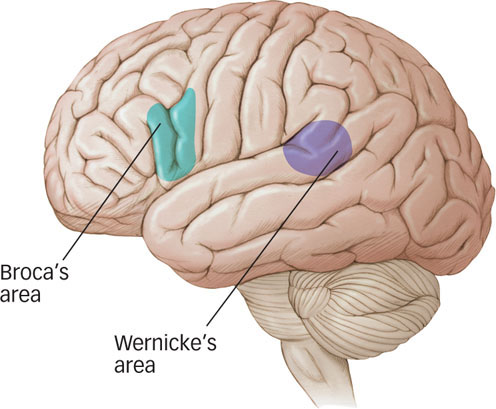9.2 Language Development and the Brain
As the brain matures, specialization of specific neurological structures takes place, and this allows language to develop (Kuhl, 2010; Kuhl & Rivera-
Broca’s Area and Wernicke’s Area of the Brain

 Figure 9.3: Broca’s and Wernicke’s Areas Neuroscientists study people with brain damage in order to better understand how the brain normally operates. When Broca’s area is damaged, people have a hard time producing sentences. When Wernicke’s area is damaged, people can produce sentences, but they tend to be meaningless.
Figure 9.3: Broca’s and Wernicke’s Areas Neuroscientists study people with brain damage in order to better understand how the brain normally operates. When Broca’s area is damaged, people have a hard time producing sentences. When Wernicke’s area is damaged, people can produce sentences, but they tend to be meaningless.
How does language processing change in the brain as the child matures?
In early infancy, language processing is distributed across many areas of the brain. But language processing gradually becomes more and more concentrated in two areas, Broca’s area and Wernicke’s area, sometimes referred to as the language centers of the brain. As the brain matures, these areas become increasingly specialized for language, so much so that damage to them results in a serious condition called aphasia, difficulty in producing or comprehending language.
Broca’s area is located in the left frontal cortex and is involved in the production of the sequential patterns in vocal and sign languages (see FIGURE 9.3). As you saw in the Psychology: Evolution of a Science chapter, Broca’s area is named after French physician Paul Broca, who first reported on speech problems resulting from damage to a specific area of the left frontal cortex (Broca, 1861, 1863). Individuals with this damage, resulting in Broca’s aphasia, understand language relatively well, although they have increasing comprehension difficulty as grammatical structures get more complex. But their real struggle is with speech production. Typically, they speak in short, staccato phrases that consist mostly of content morphemes (e.g., cat, dog). Function morphemes (e.g., and, but) are usually missing and grammatical structure is impaired. A person with the condition might say something like “Ah, Monday, uh, Casey park. Two, uh, friends, and, uh, 30 minutes.”

Wernicke’s area, located in the left temporal cortex, is involved in language comprehension (whether spoken or signed). German neurologist Carl Wernicke first described the area that bears his name after observing speech difficulty in patients who had sustained damage to the left posterior temporal cortex (Wernicke, 1874). Individuals with Wernicke’s aphasia differ from those with Broca’s aphasia in two ways: They can produce grammatical speech, but it tends to be meaningless, and they have considerable difficulty comprehending language. A person suffering from Wernicke’s aphasia might say something like, “Feel very well. In other words, I used to be able to work cigarettes. I don’t know how. Things I couldn’t hear from are here.”
In normal language processing, Wernicke’s area is highly active when we make judgments about word meaning, and damage to this area impairs comprehension of spoken and signed language, although the ability to identify nonlanguage sounds is unimpaired. For example, Japanese can be written using symbols that, like the English alphabet, represent speech sounds, or by using pictographs that, like Chinese pictographs, represent ideas. Japanese persons who suffer from Wernicke’s aphasia encounter difficulties in writing and understanding the symbols that represent speech sounds but not pictographs (Sasanuma, 1975).
363
Involvement of the Right Cerebral Hemisphere
As important as Broca’s and Wernicke’s areas are for language, they are not the entire story. Four kinds of evidence indicate that the right cerebral hemisphere also contributes to language processing, especially to language comprehension (Jung-
Bilingualism and the Brain
Early studies of bilingual children seemed to suggest that bilingualism slows or interferes with normal cognitive development. When compared with monolingual children, bilingual children performed more slowly when processing language, and their IQ scores were lower. A reexamination of these studies, however, revealed several crucial flaws. First, the tests were given in English even when that was not the child’s primary language. Second, the bilingual participants were often first-
Later studies controlled for these factors, revealing a very different picture of bilingual children’s cognitive skills. The available evidence concerning language acquisition indicates that bilingual and monolingual children do not differ significantly in the course and rate of many aspects of their language development (Nicoladis & Genesee, 1997). In fact, middle-

 Figure 9.4: Bilingualism Alters Brain Structure Learning a second language early in life increases the density of gray matter in the brain. A view of the lower left parietal region, which has denser gray matter in bilingual relative to monolingual individuals (a). As proficiency in a second language increases, so does the density of gray matter in the lower parietal region (b). People who acquired a second language earlier in life were also found to have denser gray matter in this region. Interestingly, this area corresponds to the same area that is activated during verbal fluency tasks (Mechelli et al., 2004).
Figure 9.4: Bilingualism Alters Brain Structure Learning a second language early in life increases the density of gray matter in the brain. A view of the lower left parietal region, which has denser gray matter in bilingual relative to monolingual individuals (a). As proficiency in a second language increases, so does the density of gray matter in the lower parietal region (b). People who acquired a second language earlier in life were also found to have denser gray matter in this region. Interestingly, this area corresponds to the same area that is activated during verbal fluency tasks (Mechelli et al., 2004).
364
OTHER VOICES: Americans’ Future Has to Be Multilingual

We discuss in the text some benefits of bilingualism that have been documented in recent research. Linda Moore (2012) noted several such benefits in the following article from The Washington Diplomat and argued that the American educational system should teach students foreign languages earlier than is commonly done.
We Americans must confront a stark disadvantage we face when it comes to the global economy. Some eight in 10 Americans speak only English, and the number of schools teaching a foreign language is in decline, according to a new study by the Council on Foreign Relations. But the opposite is true among our economic competitors.
While some 200 million Chinese students are learning English, only 24,000 Americans are studying Chinese, U.S. Department of Education statistics say. Foreign language degrees account for only 1 percent of all U.S. undergraduate degrees. And fewer than 2 percent of U.S. undergraduates study abroad in a given year, the Education Department says.
Our nation is largely monolingual but is entering an increasingly multilingual world. More than half of European Union citizens speak a language other than their mother tongue, and more than a quarter speak at least three languages. This is because additional languages are studied in European primary and secondary schools, and are taken up by European college students in much larger numbers than in the United States.
The Council on Foreign Relations-
For decades, our children were deprived of bilingual or multilingual education out of a mistaken belief that it took time away from other subjects, hindering students’ academic development. But recent research has shown that learning another language is a wise investment, rather than a waste. Research from the University of Georgia found that bilingual school children perform better on standardized tests including the Scholastic Aptitude Test (SAT) than their monolingual peers. A George Mason University study discovered that younger students who had enrolled in a second language immersion program outperformed those who did not in coursework, as well as on standardized tests, throughout their scholastic careers.
Educators now conclude that learning additional languages improves one’s ability to focus, plan and solve problems. Among other benefits, this means that such students are better able to move efficiently from one subject to another. The D.C.-based Center for Applied Linguistics has ascertained that the earlier we learn a foreign language, the greater the benefits. Moreover, these benefits can last a lifetime. Learning another language can help people stave off the effects of aging, including preventing the onset of dementia and other age-
I believe that teaching students foreign languages in pre-
Exposure to a new language and the skills it helps develop is a key reason that our school, where 80 percent of our students come from low-
The benefits of learning a new language go beyond the classroom. When students graduate, being fluent in a second language improves their career prospects. The Bureau of Labor Statistics reports that a number of emerging occupations need workers who can speak and write in more than one language. A University of Florida study revealed that in large, linguistically diverse cities such as Miami and San Antonio, the ability to speak a second language translates into more than $7,000 of increased annual income. We want our students to have access to these opportunities and more.
The economic importance of being bilingual is highlighted by the fact that 31 percent of company executives can speak at least two languages, according to international executive search firm Korn/Ferry.
Using multilingualism, we are expanding the scope of children’s learning at a time when public policy limits school accountability to math and reading. Most policymakers want their children to have global skill sets but do not encourage this in our public schools.
Other countries have learned this lesson and have made the necessary commitments to teach their students additional languages. Their students’ exposure to additional languages is paying dividends. I would like to see the U.S. Department of Education encourage local education authorities to invest in bilingual and multilingual education. Given the global competition for good jobs, this is not a luxury, but a necessity. It will help our children, and our nation, to succeed in the economy of tomorrow.
Are you convinced by Moore’s argument? If not, why not? And if so, how far do you think that the educational system should go in promoting multilingual education? What about the possible impact of devoting more time in early grades to teaching languages on other subjects? What kinds of research would you want to see done to evaluate the effects of early instruction in foreign languages?
Moore, L. (August 31, 2012). America’s Future Has to Be Multilingual. In The Washington Diplomat. Copyright 2012 The Washington Diplomat. Reproduced by permission. http:/
365
Some studies have revealed disadvantages, however. Bilingual children tend to have a smaller vocabulary in each language than their monolingual peers (Portocarrero, Burright, & Donovick, 2007); they also process language more slowly than monolingual children and can sometimes take longer to formulate sentences (Bialystok, 2009; Taylor & Lambert, 1990). Thus, learning a second language produces a number of benefits along with some costs.
Can Other Species Learn Human Language?
The human vocal tract and the extremely nimble human hand are better suited to human language than are the throats and paws of other species. Nonetheless, attempts have been made to teach nonhuman animals, particularly apes, to communicate using human language.

Early attempts to teach apes to speak failed dismally because their vocal tracts cannot accommodate the sounds used in human languages (Hayes & Hayes, 1951). Later attempts to teach apes human language have met with more success, including teaching them to use American Sign Language and computer-
Other chimpanzees were immersed in ASL in a similar fashion, and Washoe and her companions were soon signing to each other, creating a learning environment conducive to language acquisition. One of Washoe’s cohorts, a chimpanzee named Lucy, learned to sign “drink fruit” for watermelon. When Washoe’s second infant died, her caretakers arranged for her to adopt an infant chimpanzee named Loulis.
In a few months, young Loulis, who was not exposed to human signers, learned 68 signs simply by watching Washoe communicate with the other chimpanzees. People who have observed these interactions and are themselves fluent in ASL report little difficulty in following the conversations (Fouts & Bodamer, 1987). One such observer, a New York Times reporter who spent some time with Washoe, reported, “Suddenly I realized I was conversing with a member of another species in my native tongue.”

Other researchers have taught bonobo chimpanzees to communicate using a geometric keyboard system (Savage-
Kanzi has learned hundreds of words and has combined them to form thousands of word combinations. Also like human children, his passive mastery of language appears to exceed his ability to produce language. In one study, researchers tested 9-
366
What do studies of apes and language teach us about humans and language?
These results indicate that apes can acquire sizable vocabularies, string words together to form short sentences, and process sentences that are grammatically complex. Their skills are especially impressive because human language is hardly their normal means of communication. Research with apes also suggests that the neurological “wiring” that allows us to learn language overlaps to some degree with theirs (and perhaps with other species’).

Equally informative are the limitations apes exhibit when learning, comprehending, and using human language. The first limitation is the size of the vocabularies they acquire. As mentioned, Washoe’s and Kanzi’s vocabularies number in the hundreds, but an average 4-
The third and perhaps most important limitation is the complexity of grammar that apes can use and comprehend. Apes can string signs together, but their constructions rarely exceed three or four words, and when they do, they are rarely grammatical. Comparing the grammatical structures produced by apes with those produced by human children highlights the complexity of human language as well as the ease and speed with which we generate and comprehend it.
 Human language is characterized by a complex organization–from phonemes to morphemes to phrases and finally to sentences.
Human language is characterized by a complex organization–from phonemes to morphemes to phrases and finally to sentences. Each of these levels of human language is constructed and understood according to grammatical rules that are acquired early in development, even without being taught explicitly. Instead, children appear to be biologically predisposed to process language in ways that allow them to extract these grammatical rules from the language they hear.
Each of these levels of human language is constructed and understood according to grammatical rules that are acquired early in development, even without being taught explicitly. Instead, children appear to be biologically predisposed to process language in ways that allow them to extract these grammatical rules from the language they hear. Our abilities to produce and comprehend language depend on distinct regions of the brain, with Broca’s area critical for language production and Wernicke’s area critical for comprehension.
Our abilities to produce and comprehend language depend on distinct regions of the brain, with Broca’s area critical for language production and Wernicke’s area critical for comprehension. Bilingual and monolingual children show similar rates of language development. However, some bilingual children show greater executive control capacities, such as the ability to prioritize information and flexibly focus attention, and they tend to have a later onset of Alzheimer’s disease.
Bilingual and monolingual children show similar rates of language development. However, some bilingual children show greater executive control capacities, such as the ability to prioritize information and flexibly focus attention, and they tend to have a later onset of Alzheimer’s disease. Nonhuman primates can learn new vocabulary and construct simple sentences, but there are significant limitations on the size of their vocabularies and the grammatical complexity they can handle.
Nonhuman primates can learn new vocabulary and construct simple sentences, but there are significant limitations on the size of their vocabularies and the grammatical complexity they can handle.
367